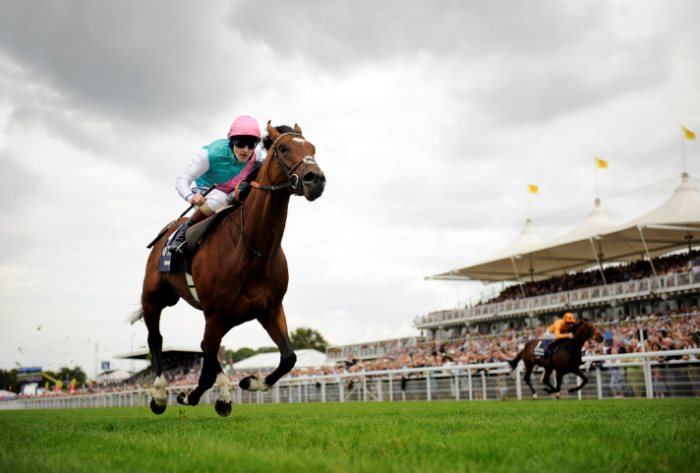What is a straight forecast bet?
< Return to what is place bettingGo to what is a reversed forecast >
What is a straight forecast bet?
· Slightly more complex and challenging, a 'Straight Forecast' requires you to successfully pick out the horses which will finish first and second in a race, in that exact order.
A straight forecast bet is a betting scenario in which you select two participants in a single sporting event and state the specific order in which they will finish, first and second.
This kind of bet is popular in race-based sports, such as horse racing, greyhound racing, cycling and motorsports. It can be easy to place but challenging to win, as it requires both the first two finishers and the order in which they finish to be correctly predicted.
Due to this accessibility, straight forecast bets are a very popular form of betting. At UK racecourses, it is usually required for those betting to put down a stake of at least £2 for a straight forecast bet.
Straight Forecast Bet
For straight forecast bets, the size of the field is normally a key consideration. The odds you are likely to get on a small field will be very different to those you get on a bigger field. This is because the chances of winning are higher if the field is small and there are fewer participants competing for those first two coveted places, than they are if you are betting on a big field, where there are more participants.
So let's imagine that you're betting on the British Grand Prix. As this is a Formula 1 race, there will normally be around 20 drivers, which means you're likely to get good odds as it's more difficult to correctly predict the result.
As part of your straight forecast bet, you predict that Lewis Hamilton will finish in first and Sebastian Vettel will finish in second. If this happens in exactly this order, you win the bet. If this does not happen and, for example, Hamilton finishes fourth with Vettel in sixth, you do not win the bet.
If the two drivers finish first and second but the roles are reversed, with Vettel winning and Hamilton coming in second, you also lose the bet. While you have correctly predicted the top two, you have failed to predict the order in which they finished.
Another option could be to place a straight forecast bet on a horse race. In this scenario, you might receive odds that look less favourable if there are fewer participants in the race and it is easier to select the top two and their order. Some might say F1 is easier to predict than horse racing though, so you have to weigh your options up, considering the odds on offer.
However, the same principle guides the bet: if you predict that Horse A will finish first and Horse B will finish second, those two horses must finish in that exact order for you to win. Any other option means you lose the bet.

Further variations in winnings feature in Tote or Pool betting. Here, your potential return is dependant upon two extra factors: the amount of money that has been bet into the pool and the number of people who make a winning bet. The more money and the fewer winners means that the people who do win will claim a larger stake.
For example, if there is £1,000 in the pool and only two people make a correct straight forecast bet, then those two people will walk away with £500 each. If there is the same pot and four people win then the winnings will decrease to just £250 each. Likewise if the pot contains £500 and five people win, those five people will earn just £100 each.
Reversed Forecast and Combination Forecast
You may hear straight forecast bets mentioned alongside two other kinds of forecast bets. These are known as a reversed forecast bet and a combination forecast bet. They are similar to a straight forecast bet, but have very different rules governing who does and does not win.
A reversed forecast bet is very similar to a straight forecast bet in that you predict who will finish first and second. However, in a reversed forecast bet, it doesn't matter which order the participants finish in. If you predict that Hamilton will win and Vettel will come second, you will win the bet even if Vettel wins and Hamilton is second. If one or both of these racers fail to finish in the top two, you will lose.
Another major difference between a reverse forecast bet and a straight forecast bet is the stake. If you bet £10 on a reverse forecast bet, you will in fact be betting £20. This is because you're essentially placing two bets. One bet is on the racers to finish in the exact order you stipulated and the other is for them to finish in the reverse order: one bet is on Hamilton first and Vettel second, and the other is on Vettel first and Hamilton second.
A combination forecast bet
This kind of bet is a much wider kind of forecast bet and allows you to bet on more scenarios. In a combination forecast you can select three participants, rather than just two, and this leads to six possible scenarios. For example, along with Hamilton and Vettel, you could also add Max Verstappen to your combination forecast bet and put a wager on who will finish first and second out of these three racers.
This would therefore lead to six possible permutations.
- In the first, you’re predicting that Hamilton will win and Vettel will finish second.
- In the second, you’re predicting that Hamilton will win and Verstappen will finish second.
- In the third, you’re predicting that Vettel will win and Hamilton will finish second.
- In the fourth, you’re predicting that Vettel will win and Verstappen will finish second.
- In the fifth, you’re predicting that Verstappen will win and Hamilton will finish second.
- In the sixth and final scenario, you’re predicting that Verstappen will win and Vettel will finish second.
As a combination forecast bet means you’re essentially making six bets in one, you will be betting six times the value of your stake. For example, if you’re betting £10, your actual stake is £60.
Plus, don't forget to check out our bet calculator, where you can calculate your winnings.
< Return to what is place bettingGo to what is a reversed forecast >















